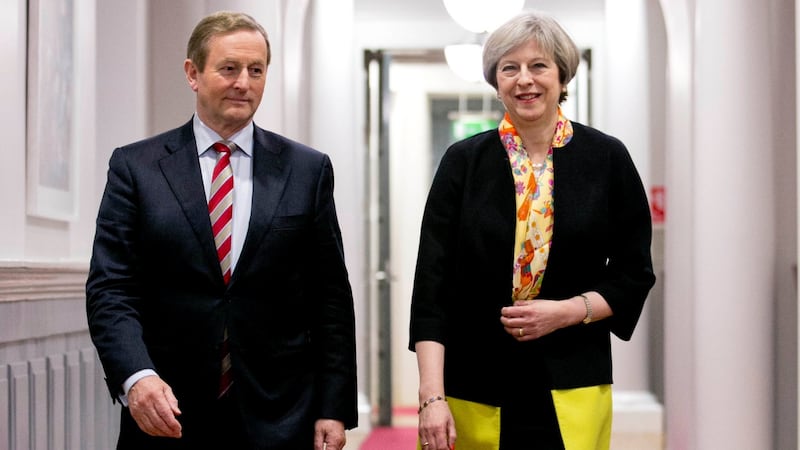Taoiseach Enda Kenny and British prime minister Theresa May have pledged to seek to avoid a hard border in Ireland, though both leaders spoke of the difficulties ahead as Britain prepares to exit the European Union.
In his prepared statement delivered to a joint press conference in Government Buildings tonight following a meeting with Ms May, Mr Kenny spoke emphatically about "the need to avoid a hard border" on the island.
“I made clear that, in my view, any manifestation of a hard border would have very negative consequences,” Mr Kenny said.

Later, Mr Kenny said the two leaders “had a frank but constructive discussion and identified a number of areas where we have further work to do together”.
“I am confident that the strengthening and deepening of our relationship in recent years will stand to us as we face into the challenges that lie ahead,” he said.
Ms May spoke of the “unique relationship” between the two countries, citing “family ties and bonds of affection”, and underscoring the economic relationship between the two countries involving €1.2 billion of trade every week, she said.
Both leaders spoke strongly about their determination to maintain the Common Travel Area between the two countries after Britain leaves the EU, with Ms May emphasising that she wanted the "reciprocal rights that our citizens enjoy in both countries to continue, including the rights guaranteed by the Belfast Agreement".
Ms May said that the "bilateral work programme" between the two administrations would continue as the preparations for Brexit advanced, something which may cause unease in Brussels, which has repeatedly said there can be no negotiations with the UK until article 50 is triggered.
‘Seamless’ border
Both Ms May and the Taoiseach said they wanted to see a “seamless” and “frictionless” border in the future.
However, neither leader spelled out how that might be possible if, as Ms May has indicated, the UK leaves the EU’s customs union in order to negotiate new trade deals with outside countries.
Both qualified their positions that they wanted to see as “seamless and frictionless” a border “as possible”.
The Taoiseach said the outcome he wanted was to have a Border that was “as trouble-free as possible”.
The two leaders also discussed the collapse of the executive in Northern Ireland, and the prospects for the return of a powersharing administration after the elections.
Both Northern Secretary James Brokenshire and Minister for Foreign Affairs Charlie Flanagan were also in attendance in Government Buildings for the meeting.
Ms May said they recognised that the problems faced by the Stormont institutions were serious, but said she wanted to see the return of a "stable devolved government that works for everyone".
In his prepared statement, Mr Kenny said he “emphasised to the prime minister the importance of finding a way forward on outstanding commitments, and in particular on issues like the Legacy Institutions under the Stormont House Agreement, and the Irish language”.
Ms May said staying fully in the customs union would leave the UK unable to agree free trade deals with other countries from around the world, which she is aiming to do.
Open borders
But she said she was working towards maintaining the border rules currently in place and stressed that Britain and Ireland had open borders “long before either of us were members of the European Union”.
“We have of course said we do not want to see a return to the border of the past - that isn’t just a phrase, actually it symbolises the sort of seamless, frictionless border that we want to see in the future,” the prime minister said.
“Of course there are elements of full membership of the customs union that would restrict our ability to trade and do trade agreements with other parts of the world.
“But I believe, and this is what we are working on, that we need to find a solution which enables us to have as seamless and frictionless a border as possible between Northern Ireland and Ireland so that we can continue to see the trade, the everyday movements, that we have seen up to now.
“And of course we also want to ensure that we carry on with the Common Travel Area, which was in existence long before either of us were members of the European Union or its predecessors.”
Additional reporting: PA









